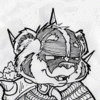
Here is a little tip for creating realistic environments and settings that I learned from building model dioramas years ago. It does you no good to spend hours slaving over exact small details of your focus object or figures if you don't take the same care with the background objects and setting. Who cares if you got every little rivet right on the 1:48 scale model jet if the starter cart parked next to it looks like a Hot Wheel!
For abakan WWII Luftwaffe commission the setting is a German airfield in early 1944. Along with the main characters and aircraft there will be the hangers along with several airfield vehicles. Now I could just thrown a kubelwagen into the background and been done with it but effective modern military and civil aircraft operations require a host of specialist vehicles.
abakan WWII Luftwaffe commission the setting is a German airfield in early 1944. Along with the main characters and aircraft there will be the hangers along with several airfield vehicles. Now I could just thrown a kubelwagen into the background and been done with it but effective modern military and civil aircraft operations require a host of specialist vehicles.
Fast, efficient refueling of aircraft requires specialized tanker vehicles or fuel trailers. While aircraft can usually taxi around under their own power most are usually moved using specialized airfield tractors. Ordnance needs to be transported from bunkers to awaiting aircraft for loading, and many modern types of ordnance need specialized lifts to assist the crews in their loading and arming. Getting many large piston and jet engine aircraft started is either easier or demands a starter carts to provide the necessary external power for start up or to extend the life of the batteries on board the aircraft. In certain extremely cold or hot conditions portable air condition or heater units maybe used to keep equipment at safe operating temperatures.
Now the Germans in WWII were masters at the art of adapting captured and commandeered vehicles into their service. They always seemed to have a chronic shortages of support vehicles and gladly took into service any spare trucks, tractors, or construction equipment they found to keep operations going. The fuel truck I plan to use in the background is one of many commercial Opel Blitz trucks that the Luftwaffe claimed for their own operations. In many cases they even left them in their civilian paint jobs, although for this picture I'll assume that this one has had a visit to the spray booth.
For
 abakan WWII Luftwaffe commission the setting is a German airfield in early 1944. Along with the main characters and aircraft there will be the hangers along with several airfield vehicles. Now I could just thrown a kubelwagen into the background and been done with it but effective modern military and civil aircraft operations require a host of specialist vehicles.
abakan WWII Luftwaffe commission the setting is a German airfield in early 1944. Along with the main characters and aircraft there will be the hangers along with several airfield vehicles. Now I could just thrown a kubelwagen into the background and been done with it but effective modern military and civil aircraft operations require a host of specialist vehicles. Fast, efficient refueling of aircraft requires specialized tanker vehicles or fuel trailers. While aircraft can usually taxi around under their own power most are usually moved using specialized airfield tractors. Ordnance needs to be transported from bunkers to awaiting aircraft for loading, and many modern types of ordnance need specialized lifts to assist the crews in their loading and arming. Getting many large piston and jet engine aircraft started is either easier or demands a starter carts to provide the necessary external power for start up or to extend the life of the batteries on board the aircraft. In certain extremely cold or hot conditions portable air condition or heater units maybe used to keep equipment at safe operating temperatures.
Now the Germans in WWII were masters at the art of adapting captured and commandeered vehicles into their service. They always seemed to have a chronic shortages of support vehicles and gladly took into service any spare trucks, tractors, or construction equipment they found to keep operations going. The fuel truck I plan to use in the background is one of many commercial Opel Blitz trucks that the Luftwaffe claimed for their own operations. In many cases they even left them in their civilian paint jobs, although for this picture I'll assume that this one has had a visit to the spray booth.
Category All / All
Species Unspecified / Any
Size 730 x 908px
File Size 105.9 kB
Similarly, I've seen a lot of (and okay, this is secondary - dioramas and stuff) photos of people using Kettenkraden as tractors to wrangle aircraft into place, late in the war. I'd assumed that reality worked that way, 'cause by that point I can't imagine them being vital to the war effort elsewhere. Did they really have enough pulling power to actually move things like Me 262s around?
I once read a book about Tank warfare in the african desert. not only were the germans adept at utilizing captured equipment, but so was everyone else. many times a tank would be abandoned on the run, for running out of fuel.
the crew would simply bug out and keep going, and the chasing army would assimilate the abandoned tank into their forces. nationality did not matter. we would happily whitewash an american star on a captured panzer 4 if we found one, gas it up and fight with it as long as the ammo held out. many times, according to the book, a tank would wander in to your camp, and out would pop one of your soldiers yelling "Look what I found!" about the only army that they knew for sure who was what were the Diggers, who would paint the silhouette of a kangaroo on their equipment.
the crew would simply bug out and keep going, and the chasing army would assimilate the abandoned tank into their forces. nationality did not matter. we would happily whitewash an american star on a captured panzer 4 if we found one, gas it up and fight with it as long as the ammo held out. many times, according to the book, a tank would wander in to your camp, and out would pop one of your soldiers yelling "Look what I found!" about the only army that they knew for sure who was what were the Diggers, who would paint the silhouette of a kangaroo on their equipment.
Now here's a topic I can sink my socket wrench into!
I love the Opel Blitz trucks. Models, prototypes, anything. Light duty commercial is my favorite class of truck.
Nice work on these. I cannot evaluate the aircraft you've been drawing, but ground based wheeled transport- THAT I can really like.
Drawing furred critters next to these seems to somehow... well, cheapen the results. They just don't look right, though I think you've done the best at making it work as best it can for that aspect.
I love the Opel Blitz trucks. Models, prototypes, anything. Light duty commercial is my favorite class of truck.
Nice work on these. I cannot evaluate the aircraft you've been drawing, but ground based wheeled transport- THAT I can really like.
Drawing furred critters next to these seems to somehow... well, cheapen the results. They just don't look right, though I think you've done the best at making it work as best it can for that aspect.

 FA+
FA+
















Comments